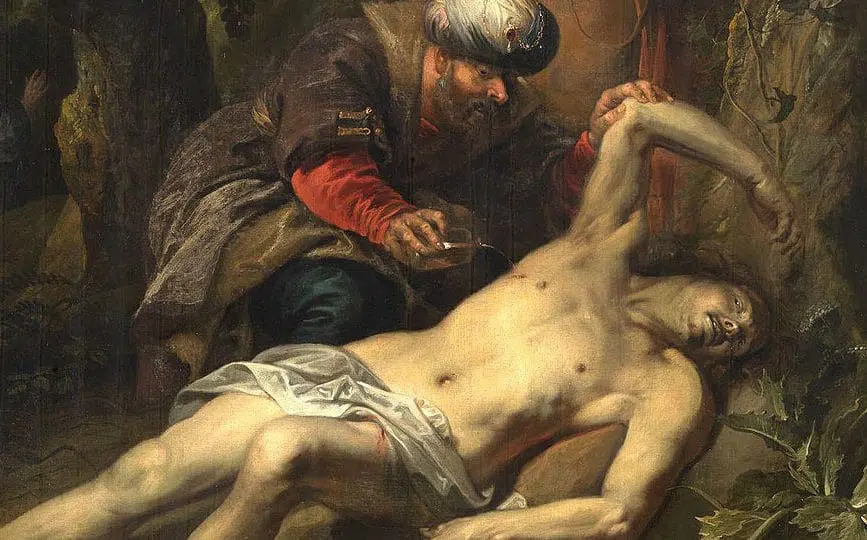June: Healing the Culture Through The Sacred Heart
It’s June. You know what that means, right? It means it’s the month of the Sacred Heart, of course!
Unfortunately, some of my readers will have thought to themselves, with sorrow, “It’s Pride month.”
I don’t blame those who did. That’s how effective the architects of the culture of death are. You have to hand it to them: they are extraordinarily adept at twisting language, using the tools of modern marketing to transform society at the most fundamental level.

However, just because the wider society is celebrating so-called “Pride” month, doesn’t mean that we cannot do our own part, in whatever small orbit we inhabit, to draw hearts and minds to something deeper and richer than the celebration of sexual license.
Fortunately, the Church has provided us with a wonderful devotion that can act as an antidote to the poison being pumped out into the airwaves and the streets of most of our major cities this month: the devotion to the Sacred Heart.
Devotion to The Sacred Heart
This beautiful devotion is one of the most popular devotions in the Catholic Church. Devotion to the Sacred Heart has ancient roots. However, the current devotion traces its roots most directly to the writings of the French nun Margaret Mary Alacoque, who lived in the 17th century. According to St. Margaret Mary, Jesus revealed this devotion to her in a series of apparitions.
As she wrote,
And He [Christ] showed me that it was His great desire of being loved by men and of withdrawing them from the path of ruin that made Him want to manifest His Heart to men, with all the treasures of love, of mercy, of grace, of sanctification and salvation which it contains, in order that those who desire to render Him and procure Him all the honour and love possible might themselves be abundantly enriched with those divine treasures of which His heart is the source.
The first celebration of a month devoted to the Sacred Heart took place in France, at the time of the French Revolution, when French cities were drenched in the blood of countless victims of The Terror, many of them priests and nuns who refused to embrace the atheism of the revolutionaries.
Then, in 1856, Pope Pius IX established the Feast of the Sacred Heart for the universal Church. Four decades later, in 1899, Pope Leo XIII issued an encyclical, Annum Sacrum, declaring that, in the “principal church of every town and village,” the faithful of the whole world should be solemnly consecrated to the Sacred Heart of Jesus.

According to Pope Leo XIII, when man, in his pride, attempts to “free” himself from God, he instead becomes a slave to his passions. When man forgets God, he loses sight of himself.
Does this sound familiar? Attend any of the massive “Pride” parades in our cities, and you will witness the spectacle of men and women who have forgotten who they are, of their deep dignity, of their calling to something much higher than the celebration of their basest passions.
The Sacred Heart In Scripture
As saints and sages have taught for millennia, the antidote to the tyranny of the passions is the cultivation of self-discipline, and, above all, of authentic, self-sacrificial love.
The heart, of course, is the most common symbol for love. That, ultimately, is what the entire devotion of the Sacred Heart is about: it is a devotion designed to draw our minds upwards, to the love of God for man, and of our calling to participate in that love to whatever measure we can.
It would be fair to say that the Gospels are nothing more than a long discourse on the nature of love. Possibly the most-quoted passage in all of Scripture is John 3:16: “For God so loved the world that he gave his only Son, so that everyone who believes in him might not perish but might have eternal life.”

If the final act of Christ’s life — His sacrifice of His very life — is the ultimate expression of what divine love looks like, it is also true that we find innumerable examples of how deeply the divine heart loves throughout the Gospels.
The depths of Christ’s compassion seem measureless: witness the tears He sheds for Lazarus, or the way that He stoops down and touches the downtrodden and the outcast, including those infected with that most dreaded disease of leprosy.
Or consider The Parable of the Good Samaritan, that most marvelous of Christ’s many parables. A few days ago, our new Pope, , ruminating on the theme of the deep compassion of Christ.
The Holy Father reflected on the strange fact that the priest and the Levite, both of whom are intimately involved in the life of the temple, pass by the man who has been robbed and left wounded by the side of the road. “The practice of worship does not automatically lead to being compassionate,” he notes. “Indeed, before being a religious matter, compassion is a question of humanity! Before being believers, we are called to be human.”
The Holy Father summarizes the message of the parable in this way:
Jesus therefore tells a parable that is a path for transforming that question, to pass from who loves me? to who has loved? The first is an immature question, the second is the question of an adult who has understood the meaning of his life. The first question is the one we ask when we sit in the corner and wait, the second is the one that drives us to set out on the path.
The Church’s Compassion
In pondering this tension between the secular celebration of Pride, and the sacred celebration of the Sacred Heart, one is consoled to recall that in Her teachings and actions, the Church demonstrates a deep compassion for those who suffer from same-sex attraction, or who are deeply enmeshed in the homosexual lifestyle.
It so often was, one recalls, Church-run clinics and hospices who ministered to those suffering from HIV/AIDS during the height of the AIDS epidemic. All around the world, it is often Church-run clinics that minister to those who are suffering the tragic consequences of their sexual behaviors, without prejudice or judgment. The tender heart of the Church loves everyone, regardless of their lifestyle or choices. The spirit of the Good Samaritan.
At the same time, it is also the Church that has stood steadfast against the pressure to water down her moral teachings, instead continuing to proclaim the truth: that sexual license of any sort, including same-sex behavior, is a pathway towards physical and spiritual death.
Charity in the Catechism
The Catechism of the Catholic Church (no., 2358) clearly teaches that people with same-sex attraction must be treated with love and respect. However, it also teaches that the promotion of same-sex sexual relationships is contrary to faith and morals, and God’s plan for human sexuality.
There is so much confusion around this issue. Sadly, sometimes this confusion is even perpetuated by people in Church leadership who are afraid to teach truth about this issue because of the perception that anything said with clarity is hateful, hurtful, and bigoted.
The Church holds that people who are living with same-sex attractions should not be discriminated against unjustly and should not be treated with malice or violence; however, she also teaches that the homosexual lifestyle and activity is contrary to God’s plan and design for human sexuality.
The Church’s role is to present the fullness of the truth of God’s plan for sexuality, which cannot change. The Church’s answer is to teach the truth more clearly about the dignity of the human person and call our brothers and sisters to a life of holiness, which always includes the virtue of chastity. We are to present a vision of human love that’s true, good and beautiful.
As His Eminence, Frank Cardinal Leo, the Archbishop of Toronto recently said:
We need to make sure that the symbols we use are consistent with our Catholic faith and not borrowed from ideological fora, promoted by lobby groups and endorsed by political movements. We ought to honour and respect our traditions and not compromise the integrity of the faith by using symbols that are contrary to God’s divine revelation. We do good to use our own symbols to tell our own story without resorting to trendy, misguided and inadequate symbols that do not represent us as Catholics but rather contribute to confusion, distortions and ambiguities about what the Catholic faith truly teaches regarding the human person, human nature, and natural moral law.
At the very heart of the Church’s teaching on this difficult issue, is love. The LBTQ ideology loves to say, “love is love,” but this is not true. To love, to truly love, is to will the good of the beloved. The Church’s teachings do not mean that there cannot be found care, concern, and love within same-sex relationships. However, to the degree that they pursue a disordered use of sexuality, they are contrary to love. The truth is that human sexuality has meaning, purpose, and design. It is for something: for procreation and union.
Meditate Upon the Sacred Heart
Devotion to the Sacred Heart reminds us that Jesus transforms those who meditate upon His precious gift of Himself.
And it calls us to imitate His love, which we see illustrated so powerfully in The Parable of the Good Samaritan.

It is worth returning to Pope Leo XIV’s meditation upon the parable. In it, he notes, “Compassion is expressed through practical gestures.” The Good Samaritan, he notes, is willing to risk being late to whatever it is that he is going. He does not worry about being contaminated. Instead, he cleans and binds his wounds, carries him to a place of rest, and pays for the man’s care.
“Dear brothers and sisters,” the Holy Father asks his listeners, “when will we too be capable of interrupting our journey and having compassion? When we understand that the wounded man in the street represents each one of us. And then the memory of all the times that Jesus stopped to take care of us will make us more capable of compassion.”
The Holy Father concluded his meditation, urging his listeners to “turn…to the Sacred Heart, model of true humanity, and ask him to make our heart ever more like his.”
“Let us pray…that we can grow in humanity,” he said, “so that our relationships may be truer and richer in compassion. Let us ask the Heart of Jesus for the grace increasingly to have the same feelings as him.”
Human Life International
As president of Human Life International, Fr. Boquet is a leading expert on the international pro-life and family movement, having journeyed to nearly 90 countries on pro-life missions over the last decade. Father Boquet works with pro-life and family leaders in 116 counties that partner with HLI to proclaim and advance the Gospel of Life. Read his full bio here.







The church never seems to advocate chastity of any sort. Most men pressure the girls who are looking for love and marriage into sex they don’t really want, and then disappear while she gets an abortion. And even if she doesn’t get pregnant, she waits and waits until he takes up with someone else. Thanks to the sexual revolution, the world is teeming with lonely women.
The church could help women say no, and even encourage men to look for love, not just sex.
Hi Laurie,
The Catholic Church does advocate for chastity. There is a section that is dedicated entirely to chastity in the Catechism of the Catholic Church (CCC paragraphs 2331-2391; especially, CCC paragraphs 2337-2356 [Catechism of the Catholic Church – vatican.va] & 2391).
Specifically pertaining to chastity in a pre-marital relationship, the Catechism states:
“Those who are engaged to marry are called to live chastity in continence. They should see in this time of testing a discovery of mutual respect, an apprenticeship in fidelity, and the hope of receiving one another from God. They should reserve for marriage the expressions of affection that belong to married love. They will help each other grow in chastity.” (CCC 2350)
The second part of this issue is the education of young men and women in chastity. While the Catholic Church has explicit teachings about the beauty of chastity and the dangers of immorality (see CCC paragraphs 2338-2339), there is often a disconnect preventing the reception of these teachings by young people. There are many places where this disconnect may occur, but the result is often that young people discover the dangers of immorality first-hand.
One suggestion regarding the bridging of this gap is mentorship. With good, trustworthy, and faithful mentors (whether they are parents, older relatives, priests, religious sisters, teachers, coaches, family friends, etc.), a young person will receive the guidance that they need and will be given a glimpse of the beauty of authentic and integrated chastity (through both words and actions). Also, should the young person fall into immorality, they will have a trusted mentor to turn to who can help them reintegrate the beautiful life of chastity into their own life. However, the young person would need to both be able to trust that the mentor has their best interests in mind and be in a disposition that allows for them to receive guidance.
While this isn’t a fail-safe solution, it is the best defense against the constant external intrusions by the culture which often lean towards immorality, and it also serves as a protection from the influence of those Catholics who, unfortunately, have fallen into immorality.
– HLI Staff
Pope Leo XIV & Cardinal Leo of Toronto are two Lions of The One True Church of Jesus Christ. We are in Good Hands.